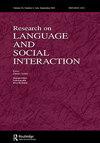Self-Reformulation as a Preemptive Practice in Talk Addressed to L2 Users
IF 2.1
1区 文学
Q1 COMMUNICATION
引用次数: 0
Abstract
ABSTRACT Self-reformulation is when a speaker produces a “second saying” of something, changing the wording but keeping the semantic content more or less unaltered. This conversational practice may constitute a method for avoiding potential understanding problems in talk addressed to second language users. Speakers preempt problems by substituting a potentially problematic word or construction with a version that is more recipient designed—that is, better adapted to the assumed linguistic competence and background knowledge of the interlocutor. The reformulations are self-initiated but may be triggered by a lack of response by the interlocutor. They may substitute for the original formulation by an alternative referring expression or by an explanation of word meaning. While most reformulations display an orientation to simplifying the wording, some instances involve reformulation from an everyday term to a technical one, displaying an orientation to language teaching. Data are in Norwegian.自我重构:对第二语言使用者演讲的先发制人实践
自我重塑是指说话者在改变措辞的同时,或多或少地保持语义内容不变,对某件事做出“第二种说法”。这种会话练习可能是一种避免与第二语言使用者交谈时潜在的理解问题的方法。说话者会先发制人,用更适合接受者的方式来替换可能有问题的词或结构——也就是说,更适应对话者假定的语言能力和背景知识。重新表述是自我发起的,但也可能因对话者缺乏回应而触发。他们可以用另一种指称表达或对词义的解释来代替原来的表述。虽然大多数的重新表述倾向于简化措辞,但有些例子涉及从日常术语到技术术语的重新表述,显示出语言教学的倾向。数据为挪威语。
本文章由计算机程序翻译,如有差异,请以英文原文为准。
求助全文
约1分钟内获得全文
求助全文
来源期刊
CiteScore
7.30
自引率
7.40%
发文量
20
期刊介绍:
The journal publishes the highest quality empirical and theoretical research bearing on language as it is used in interaction. Researchers in communication, discourse analysis, conversation analysis, linguistic anthropology and ethnography are likely to be the most active contributors, but we welcome submission of articles from the broad range of interaction researchers. Published papers will normally involve the close analysis of naturally-occurring interaction. The journal is also open to theoretical essays, and to quantitative studies where these are tied closely to the results of naturalistic observation.

 求助内容:
求助内容: 应助结果提醒方式:
应助结果提醒方式:


